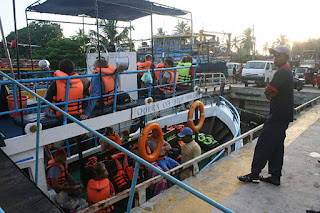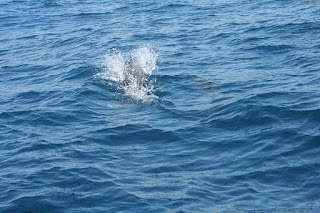January started off well and a trip overseas to Sri Lanka happened. I've been to this beautiful island Nation many times in the past but now that the internal conflict is over and peace reigns, its a greater pleasure to visit and do business or go on a holiday.
Before I start off on my Whale of a Tale, let me update some important information on travel to Sri Lanka. As of January 2012, all visitors to Sri Lanka need to apply and obtain an ETA (Electronic Travel Authorization) before embarking on their trip. The one-arrival visa has been scrapped for all Nationalities except Singapore and Maldives, both of whom have given visa free entry to Sri Lankans and hence the reciprocal benefits. An ETA is Visa that you apply, pay and receive approval entirely online. It is a very simple process, just visit this website and follow easy instructions: http://www.eta.gov.lk/slvisa/ It took me 10 minutes to complete, cost me $10 for a double entry visit visa and authorization came by email very soon after. For a limited time, the SL Authorities will still allow foreigners to come without the Authorization, go to an ETA desk at the airport, fill up forms, get Authorization and then go for immigration clearance. This will cost you more and waste so much time and the service may not be available in a couple of months time, so its better to do it online like I did.
(whale watching boat)
Mirissa is a fishing port about 40 kilometres due East from Galle in Southern Sri Lanka. No one visited the place during conflict years because there was nothing going on except fishing. With the onset of peace and information moving freely, it soon came to light that a few Kms into the sea off Dhondra Point was a pod of "resident"Blue Whales. The best whale watching season in this area is between December and March. All of a sudden, with the news of the whales spreading, the sleepy village of Mirissa became a hotbed of activity with new hotels coming up and new boat operators taking to the Whale watching business. The Sri Lankan Navy pioneered the whale watching trips and still operate on certain days.
(Look for the fine mist when the whale exhale)
What are these Blue Whales, you may ask. To put it simply, they are the largest animal on the entire planet. There is nothing living on Earth that comes even close in size to these magnificent leviathans of the Deep. Nothing. More info on these beautiful mammals of the Deep is available on another blog mentioned below. Whale watching trips leave very early in the morning and hotel pick ups start around 0600Hrs. There are around a dozen or more boats of various sizes and configuration, that are privately owned and operated. The charges can range from LKR 5,000 to LKR 9,000 (1 US$ = 113 LKR) per person. Once everyone's settled in the boat and life jackets put on, the Coast Guard comes along and takes down the names, passport number and signature of the passengers and makes sure that no boat is carrying more than 25 people. While this is good practise, there is no order or method to the operation of these Whale boats and their methods of chasing down whales leaves much to be desired among us Cetacean lovers who know a thing or two about Dolphins and Whales.
(This is close and they chose to surface nearby as we had no clue and were looking around for them)
So, after the headcount and paperwork got over, we left the fishing harbor of Mirissa and chugged into the open Indian Ocean. Bread and cheese was served followed by bananas and bottles of water. It so happened, in a season known for flat water, a regional storm had affected the waves and it turned out to a jolly old nightmare. Jolly for me because I enjoyed the Wild heaving of the boat and thanks to my sea-legs, the Boat crew and I were left standing and nightmare for the remaining passengers, mostly foreigners who were constantly throwing up. For those who are naturally seasick or don't know if they are, maybe you should take some seasickness/motion sickness pills before the voyage.
(lone dolphin torpedoing on fish)
A brief glimpse of two Bottle nose Dolphins got our interest going and the anticipation of finding the big Blue Whales soon started to build up, an hour out at sea, heading into deeper waters. Two hours later and seeing plastics floating around in the Ocean thanks to humans all over the World dumping them everywhere, we finally managed to sight a spouting, a fine mist of air and water that is thrown up like a fountain when a Whale surfaces to exhale. Soon, the boats that had all spread over the Ocean started to chug to this point at full speed. After chasing more whale spouts here and there, we were finally lucky to get close to three of them just as they broke the surface and dived underwater. On a day of flat seas, one would have been able to take good photographs but on heaving seas, only a brief respite in the roughness coinciding with the whales surfacing, made it happen for our group.
(pod of dolphins)
After 3 hours, the boat decided to leave the poor Whales to their feeding undisturbed and made way back to the harbor. On the return, we were treated to a delightful pod of Dolphins that were corralling fish together into a ball and tearing through them to feed. That was the highlight of the trip.
I made it to Galle for the evening and settled down near the sea shore at a chalet. It was back to Colombo the next day. While this trip was a week of good times and meeting people, there are more trips to Sri Lanka this year in the offing. There will be opportunities for me to visit more places and re-visit all the places that I have been to, in the past. More blogs may follow those visits.
(video of the dolphin pod)
For those who want to read more about Blue Whales of Sri Lanka, this wonderful researcher friend Asha De Vos, a Sri Lankan doing her PhD in Australia, writes her blogs and posts her pictures and gives details about them, their feeding, their habitat and so on. Visit her blog here. Asha is also featured in this Aussie Video program about Blue Whales in Sri Lanka, just discount the title of the video because the size of the whale pods are not known and the title claims that this is the biggest colony in the World. Never mind that, watch the video above. There are other whales that visit these waters such as Sperm whales, we didn't see any but I'm hoping that someday in future, I'd be able to say hello to one.
Sri Lanka has everything going for it now. The friendly people, the beautiful tea gardens and of it's high mountain lakes and streams, the fabulously spicy food, the culture of thousands of years, UNESCO World Heritage sites, the land of Elephants and the famed Leopards of Yala and now, the magnificent Blue Whales. It's not like you needed one more reason to visit but it is there now. Enjoy responsibly, as green as possible (and I don't mean from being seasick!), visit and leave nothing behind except footprints and take away nothing except memories. Leave the environment as pristine as you found it.




